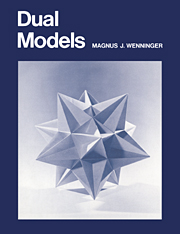Book contents
- Frontmatter
- Contents
- Foreword by John Skilling
- Preface
- Introduction
- I The five regular convex polyhedra and their duals
- II The thirteen semiregular convex polyhedra and their duals
- III Stellated forms of convex duals
- IV The duals of nonconvex uniform polyhedra
- V Some interesting polyhedral compounds
- Epilogue
- Appendix: Numerical data
- References
- List of polyhedra and dual models
III - Stellated forms of convex duals
Published online by Cambridge University Press: 07 October 2009
- Frontmatter
- Contents
- Foreword by John Skilling
- Preface
- Introduction
- I The five regular convex polyhedra and their duals
- II The thirteen semiregular convex polyhedra and their duals
- III Stellated forms of convex duals
- IV The duals of nonconvex uniform polyhedra
- V Some interesting polyhedral compounds
- Epilogue
- Appendix: Numerical data
- References
- List of polyhedra and dual models
Summary
The stellation process as it applies to the regular solids was fully explained in Polyhedron models. A commentary on the stellation of semiregular solids was also given, along with a representative set of stellated models of the two quasi-regular solids, the cuboctahedron and the icosidodecahedron. My own investigation of other Archimedean forms has now led me to see that the stellation process applied to convex duals gives far more interesting and aesthetically pleasing results.
In this section you will find a more elaborate presentation of such stellated models, in preparation for further use to be made of this in the study of nonconvex duals. The first important feature you will notice here is that only one stellation pattern is needed, because dual forms have only one type of face. Secondly, as the number of faces increases, the numbers and shapes of the basic cells generated by the stellation process become bewilderingly complex. A complete investigation of even some of the simpler duals is already a challenge.
The rhombic dodecahedron, dual of the cuboctahedron, is the simplest, because, strangely enough, only one type of cell is generated in the stellation process. This is fully presented by Cundy and Rollett in Mathematical models and is attributed to Dorman Luke. J. Ede investigated the stellations of the rhombic triacontahedron, dual of the icosidodecahedron, and G. Pawley set down some restrictive rules by which a complete enumeration of its stellated forms might be made.
- Type
- Chapter
- Information
- Dual Models , pp. 36 - 38Publisher: Cambridge University PressPrint publication year: 1983
- 1
- Cited by



